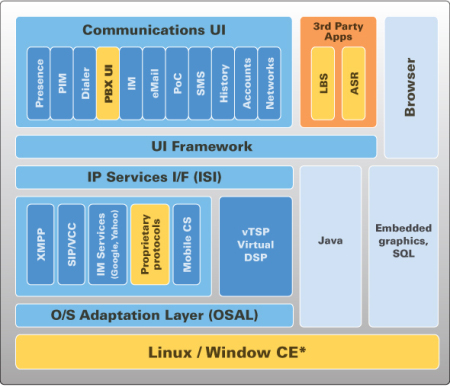VoIP-over-WiMAX design runs Linux
Feb 2, 2009 — by Eric Brown — from the LinuxDevices Archive — 2 views [Updated: 11AM] — D2 Technologies is shipping a WiMAX mobile-phone reference design based on Linux, with Google Android and Windows CE/Mobile flavors to follow in Q2. The “dual-mode” design can mix and match WiMAX, WiFi, and cellular radios, and uses a Texas Instruments OMAP-based processor.
[Updated: 11AM] — D2 Technologies is shipping a WiMAX mobile-phone reference design based on Linux, with Google Android and Windows CE/Mobile flavors to follow in Q2. The “dual-mode” design can mix and match WiMAX, WiFi, and cellular radios, and uses a Texas Instruments OMAP-based processor.
(Click for larger view of D2's mCUE contacts interface)
D2, an embedded IP communications software firm that has offered Linux-ready VoIP stacks for WiFi-enabled smartphones, says that it will privately demonstrate the reference design this week at ITExpo East 2009 in Miami. The design is said to be a turnkey solution for handsets and “similar portable devices” that combine any two of the following radios: WiMAX, WiFi, and cellular.
The reference design is built on an undisclosed OMAP platform from Texas Instruments (TI), which is probably the handset-oriented OMAP34xx system-on-chip (SoC), or possibly one of the general-purpose OMAP35xx SoCs. Both OMAP platforms incorporate ARM's superscalar Cortex-A8 processors.
The OMAP3 chips are available with or without a built-in TI DSP (digital signal processor). We're guessing the design eschews a hardware DSP, since it is said to include D2's softDSP VoIP engine. Also included is D2's mCUE mobile client stack (diagram below), along with codecs, error correction, jitter buffer, and a host of other VoIP technology, says the company. The design reportedly supports standard IMS-SIP, along with an alphabet soup of more proprietary VoIP technologies.

mCUE architecture
(Click to enlarge)
mCUE features are said to include:
- Presence-based and push-to-x controls
- Cellular and VoIP calls (though cellular likely not used in this design)
- PBX feature activation
- IM, email, and SMS
- Interoperability with communications services like IP PBXs and UC systems
- Interoperability with commercial “VoIM” services like Google Talk, Yahoo!, MSN, and AIM
- Customizable UI elements, including contacts address book with presence (see image at top) and IM chat
Stated Doug Makishima, VP of marketing and sales at D2 Technologies, “The industry is pouring tremendous resources into the creation and delivery of a WiMAX infrastructure, and manufacturers will need a fast and cost-effective way to develop mobile devices that take advantage of the greater bandwidth, range, and other benefits of this technology.”
Availability
D2 Technologies will privately demonstrate the Linux reference design at ITExpo East 2009 in Miami, Florida, from Feb. 2-4. The Google Android and Windows CE/Mobile versions are due in the second quarter. More on the underlying mCUE software may be found here.
This article was originally published on LinuxDevices.com and has been donated to the open source community by QuinStreet Inc. Please visit LinuxToday.com for up-to-date news and articles about Linux and open source.